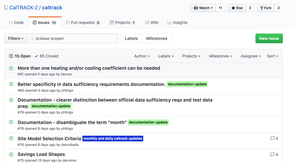 As we complete Week Two (2/12-2/16), we conclude our discussion of “Proposals for Monthly and Daily Methods Updates” and begin testing proposed methods. Here are the six main updates to the daily and monthly methods (click links to jump to GitHub): Criteria for choosing weather stations
Adjustment to monthly data for models
Defining maximum baseline period
Include search grid to determine balance points on Monthly Methods
Expand Balance Point Search Range
Site Model Selection Criteria
In this upcoming week (starting 2/19), we look forward to beginning the testing process for our daily and monthly methods! We are encouraging participants to test models on their own data and share results on the GitHub. Please include information about data characteristics with the results. Homework:
0 Comments
Leave a Reply. |
The purpose of this blog is to provide a high-level overview of CalTrack progress.
For a deeper understanding or to provide input on technical aspects of CalTrack, refer to the GitHub issues page (https://github.com/CalTRACK-2/caltrack/issues). Recordings
2019 CalTRACK Kick Off:
CalTRACK 2.0 July 19, 2018 June 28, 2018 June 7, 2018 May 24, 2018 May 3, 2018 April 12, 2018 March 29, 2018 March 15, 2018 March 1, 2018 February 15, 2018 February 1, 2018 Archives
March 2024
|

 RSS Feed
RSS Feed
